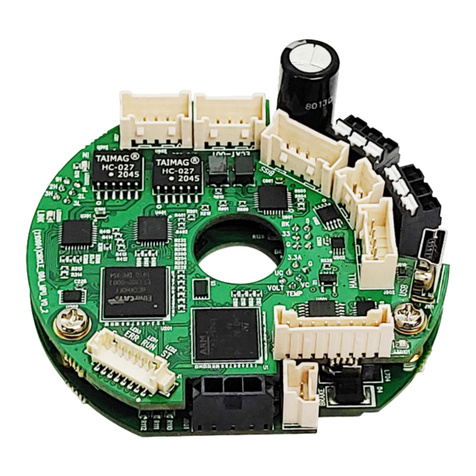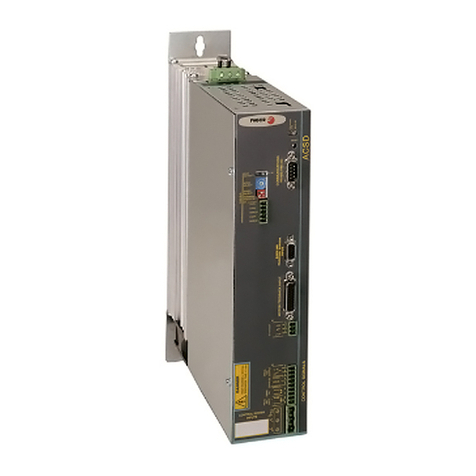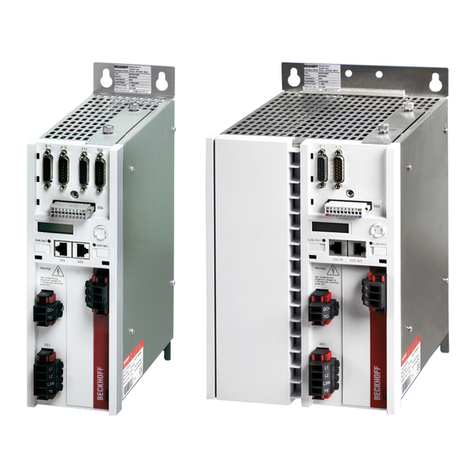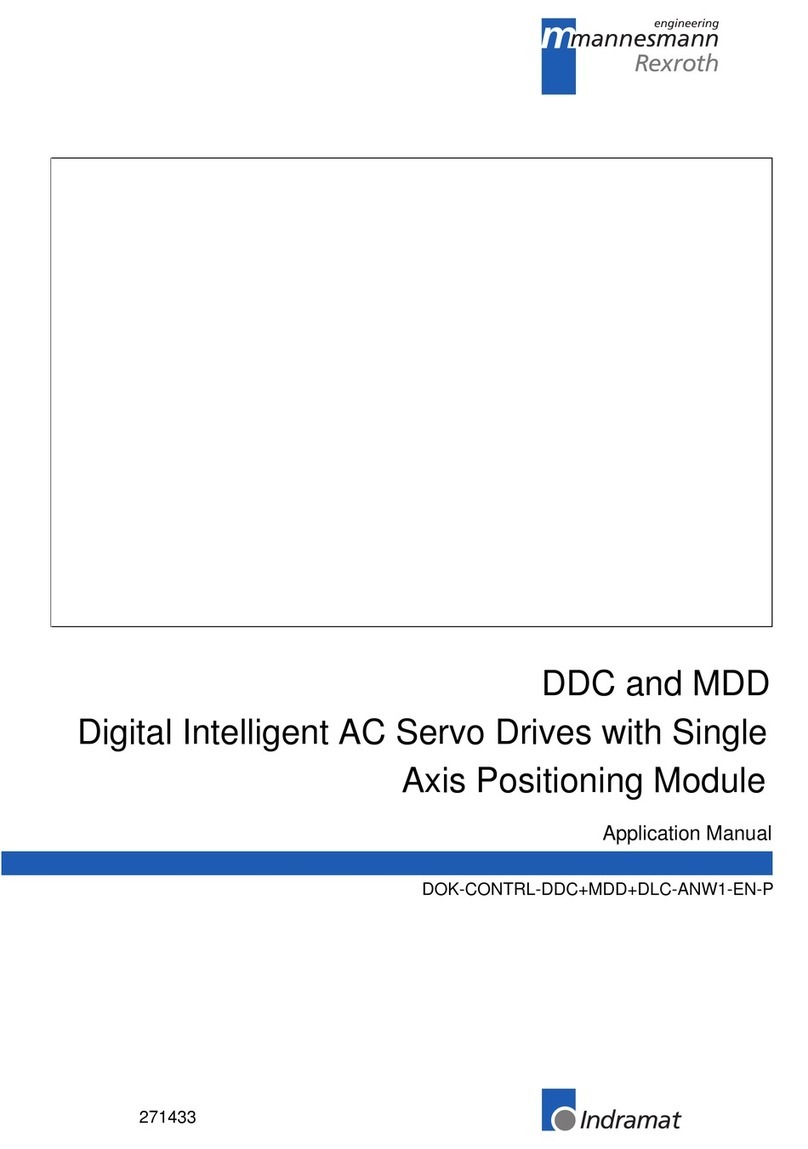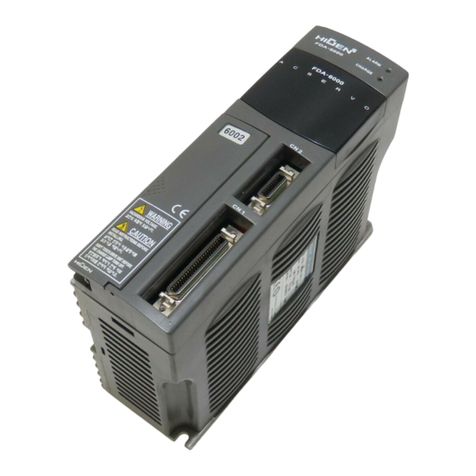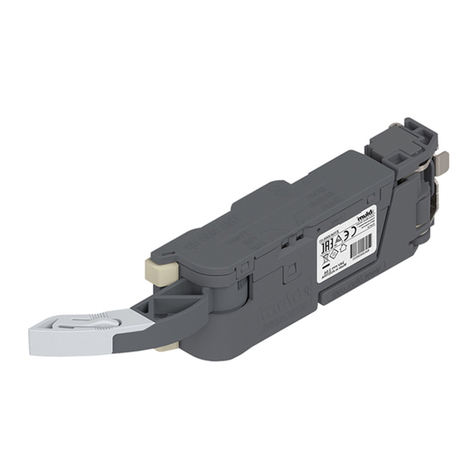Infranor XtrapulsGem User manual

EtherCAT®
Fieldbus Interface
XtrapulsGem
XtrapulsPac

2
CAUTION
This is a specific manual describing the EtherCat® fieldbus interface.
It must be used in conjunction with the Installation, User and Programming manuals of the Xtrapuls drives.
Instructions for storage, use after storage, commissioning as well as all technical details require the
MANDATORY reading of the manual before getting the amplifiers operational.
Maintenance procedures should be attempted only by highly skilled technicians having good knowledge
of electronics and servo systems with variable speed (EN 60204-1 standard) and using proper test
equipment.
The conformity with the standards and the "CE" approval is only valid if the items are installed according to the
recommendations of the amplifier manuals. Connections are the user's responsibility if recommendations and
drawings requirements are not met.
INFRANOR does not assume any responsibility for any physical or material damage due to improper handling or
wrong descriptions of the ordered items.
Any intervention on the items, which is not specified in the manual, will immediately cancel the warranty.
Infranor reserves the right to change any information contained in this manual without notice.
©INFRANOR,January 2010. All rights reserved.
Issue: 1.0
!
Any contact with electrical parts, even after power down, may involve physical damage.
Wait for at least 5 minutes after power down before handling the amplifiers (a residual voltage of several
hundreds of volts may remain during a few minutes).
ESD INFORMATION (ElectroStatic Discharge)
INFRANOR amplifiers are conceived to be best protected against electrostatic discharges. However,
some components are particularly sensitive and may be damaged if the amplifiers are not properly
stored and handled.
STORAGE
- The amplifiers must be stored in their original package.
- When taken out of their package, they must be stored positioned on one of their flat metal
surfaces and on a dissipating or electrostatically neutral support.
- Avoid any contact between the amplifier connectors and material with electrostatic potential
(plastic film, polyester, carpet…).
HANDLING
- If no protection equipment is available (dissipating shoes or bracelets), the amplifiers must
be handled via their metal housing.
- Never get in contact with the connectors.
ELIMINATION
In order to comply with the 2002/96/EC directive of the European Parliament and of the Council of
27 January 2003 on waste electrical and electronic equipment (WEEE), all INFRANOR devices
have got a sticker symbolizing a crossed-out wheel dustbin as shown in Appendix IV of the
2002/96/EC Directive.
This symbol indicates that INFRANOR devices must be eliminated by selective disposal and not
with standard waste.
X
trapuls – EtherCAT® Fieldbus Interface

3
X
trapuls – EtherCAT® Fieldbus Interface
Contents
Content
CONTENTS............................................................................................................................................. 3
CHAPTER 1 - INTRODUCTION ............................................................................................................. 4
CHAPTER 2 - BASIC INFORMATION ABOUT ETHERCAT®.............................................................. 5
2.1 -MAIN ETHERCAT® SLAVE FUNCTIONS ............................................................................................ 5
2.2 -ETHERCAT® STATE MACHINE ....................................................................................................... 6
2.3 -ETHERCAT® FIELDBUS TOPOLOGY................................................................................................. 7
CHAPTER 3 - ELECTRICAL INSTALLATION....................................................................................... 8
3.1 -CONNECTORS................................................................................................................................. 8
3.1.1 "IN" connector: E3 (XtrapulsGem EtherCAT® extension board), X6 (XtrapulsPac) .............. 8
3.1.2 "OUT" connectors: E4 (XtrapulsGem EtherCAT® extension board), X7 (XtrapulsPac) ........ 8
3.2 -INDICATORS.................................................................................................................................... 8
3.2.1 - Link/Activity Indicators........................................................................................................... 8
3.2.2 - Run indicator.......................................................................................................................... 9
3.2.3 - Error indicator........................................................................................................................ 9
3.3 SLAVE ADDRESSING MODES .............................................................................................................. 9
CHAPTER 4 - SPECIFICATIONS OF THE SDOS AND PDOS FOR THE ETHERCAT® EXTENSION
BOARD.................................................................................................................................................. 10
4.1 -SDO............................................................................................................................................ 10
4.1.1 – Sync manager communication type.................................................................................... 10
4.1.2 – Sync manager channel 0 PDO assignment........................................................................ 11
4.1.3 – Sync manager channel 1 PDO assignment........................................................................ 11
4.1.4 – Sync manager channel 2 PDO assignment........................................................................ 12
4.1.5 – Sync manager channel 3 PDO assignment........................................................................ 12
4.1.6 – Synchronisation clock object .............................................................................................. 13
4.1.7 – Read access to the Fieldbus controller registers................................................................ 13
4.1.8 – RPDO watchdog time ......................................................................................................... 13
4.1.9 – Fieldbus Specific Error bits in the Error Code 1 object (0x3022)........................................ 14
4.1.10 – Fieldbus Specific warning bits in the warning code object (0x3024)................................ 14
4.2 -PDO PARTICULARITIES ................................................................................................................. 15
CHAPTER 5 - SYNCHRONISATION OF XTRAPULS ETHERCAT® SLAVES.................................. 16
SYNC TYPE 0: SYNCHRONISATION AND PROCESS DATA EXCHANGE DISABLED .......................................... 16
SYNC TYPE 1: SYNCHRONISATION DISABLED AND PROCESS DATA EXCHANGE ENABLED............................ 16
SYNC TYPE 2: SOFT SYNCHRONISATION ................................................................................................ 16
SYNC TYPE 4:HARD SYNCHRONISATION (STIFF) .................................................................................... 16

4
X
trapuls – EtherCAT® Fieldbus Interface
Chapter 1 - Introduction
Chapter 1 - Introduction
The purpose of this manual is to provide the user with a support when designing an application and configuring
the EtherCAT®1communication.
The EtherCAT® fieldbus interface allows the Xtrapuls drives to be used in an EtherCAT® communication network
using the CANopen over EtherCAT® protocol. These drives do not support the Ethernet over EtherCAT®
protocol.
In this manual, the EtherCAT® slave is supposed to be:
•the XtrapulsGem drive equipped with an EtherCAT® extension board,
•the XtrapulsPac-et drive.
1EtherCAT® is a registered trademark and patented technology, licensed by Beckhoff Automation GmbH,
Germany.

5
X
trapuls – EtherCAT® Fieldbus Interface
Chapter 2 – Basic information about EtherCAT®
Chapter 2 - BASIC INFORMATION ABOUT
EtherCAT®
EtherCAT® (“Ethernet for Controller and Automation Technology”) is a real-time Ethernet-based fieldbus.
2.1 - MAIN ETHERCAT® SLAVE FUNCTIONS
The following EtherCAT® slave node reference model makes it easy to locate the impact of the EtherCAT®
specific functions on the communication architecture.
The green box contains the modules belonging to the CANopen communication profile. This profile is
implemented in the Xtrapuls drives (please see “Xtrapuls User Guide” for more details about this communication
profile).
The red box contains the modules that belong to the EtherCAT® Slave Controller (ESC) on the EtherCAT®
Extension Board.
The EtherCAT® frame is initiated by the EtherCAT® master which sends this frame to the first EtherCAT®
slave. An EtherCAT® frame can contain several telegrams. If one of the telegrams is assigned the first slave, it
will process this telegram by inserting or extracting data respectively in or from the frame. The frame is then
transmitted to the next EtherCAT® slave which makes the same. The last EtherCAT® slave receiving the frame,
will also process it, and then returns the frame to the master via all slaves. To perform such a processing, two full-
duplex communication ports are controlled.
FMMUs
Mailbox
SM0 : out
SM1 : in
Process Data
SM2 : out
SM3 : in
AL Control/
AL Status
Distributed
Clock
DL Control/
DL Status
DL Info
EtherCAT®
State
Machine
SDO PDO
Ob
j
ect Dictionar
y
SM
Settin
g
s
Ph
y
sical La
y
e
r
Data Link Layer
Application Layer
Ethernet Ph
y
sical La
y
er
(
100Base-TX or 100Base-FX
)
or LVDS
CANopen Profile
EtherCAT® Data Link Layer

6
X
trapuls – EtherCAT® Fieldbus Interface
Chapter 2 – Basic information about EtherCAT®
2.2 - ETHERCAT® STATE MACHINE
The EtherCAT® master controls the following state machine in every slave:
Description of the states and the transitions:
State Description
Init Initial state at the power on. Amplifier configuration is performed. No communication.
Pre-Op SM0 and SM1 are active : SDO exchange is possible.
Safe-Op SM0, SM1, SM3 are active : SDO and TPDO exchange is possible. DC generates event.
Operational SM0, SM1, SM2 and SM3 are active : SDO, TPDO and RPDO exchange is possible. DC generates event.
Transition Actions
IP Start SDO
PI Stop SDO
PS Start TPDO
SP Stop TPDO
SO Start RPDO
OS Stop RPDO
OP Stop RPDO and TPDO
SI Stop TPDO and SDO
OI Stop RPDO, TPDO and SDO
The internal register called “AL Status Code” (Address 0x134:0x135) indicates the eventual error cause of an
unsuccessful transition. This code can be read by using the object called “Extension Board Access“with index
0x2320, sub-index 0. The following table lists the supported AL status error codes:
Code Description Transition Resulting state
0x0000 no error any current state
0x0011 invalid request change I->S, I->O, P->O current state
0x0012 unknown request change current state
0x0013 bootstrap not supported I->B I
0x0016 invalid mailbox configuration I->P I
0x001D invalid output configuration 0, S, P->S S
0x001E invalid input configuration 0, S, P->S P
0x0026 inconsistent settings P->S P
0x0029 free run needs 3-buffer mode P->S P
0x0030 invalid DC SYNCH configuration 0, S S
0x0036 invalid DC SYNC0 cycle time 0, S S
0x8000 mother board watchdog expired I->P I
(OI)
Init
Pre-O
p
Safe-O
p
O
p
erational
(IP) (PI)
(PS) (SP)
(OP)
(SO) (OS)
(SI)

7
X
trapuls – EtherCAT® Fieldbus Interface
Chapter 2 – Basic information about EtherCAT®
2.3 - ETHERCAT® FIELDBUS TOPOLOGY
In motion control applications, EtherCAT® slaves are connected together in one line. The physical layer
technology employed by the EtherCAT® fieldbus is the 100BASE-TX. The EtherCAT® master is connected at
one end of the line.
RJ-45 sockets on EtherCAT® slaves are labelled “IN” and “OUT”.
The EtherCAT® master should be connected to the first EtherCAT® slave using the “IN” RJ-45 socket of the
EtherCAT® slave.
The cables used for an EtherCAT® network need to be of category 5e quality. Maximum cable length should be
100 m. The following table indicates the pin function and the wire colors (see T 568-B standard for more
information).
Pin T568B Color Function
1 white/orange stripe TxData +
2 orange solid TxData -
3 white/green stripe RecvData +
4 blue solid Not used
5 white/blue stripe Not used
6 green solid RecvData -
7 white/brown stripe Not used
8 brown solid Not used
IN
OU
T
EtherCAT®
Slave
1
IN
OU
T
EtherCAT®
Slave
2
IN
OU
T
EtherCAT®
Slave
n
EtherCAT®
Master
1 8

8
X
trapuls – EtherCAT® Fieldbus Interface
Chapter 3 – Electrical installation
Chapter 3 - Electrical installation
3.1 - CONNECTORS
On the XtrapulsGem EtherCAT® extension board, the EtherCAT® fieldbus connectors E3 and E4 are located on
the front panel.
On the XtrapulsPac drive, the EtherCAT® fieldbus connectors X6 and X7 are located on the top of the drive.
3.1.1 "IN" CONNECTOR:E3 (XTRAPULSGEM ETHERCAT® EXTENSION BOARD), X6 (XTRAPULSPAC)
PIN SIGNAL DESCRIPTION
1 Tx Data+ Differential signals
2 Tx Data-
3 Rx Data+ Differential signals
6 Rx Data-
Others Reserved
3.1.2 "OUT" CONNECTORS:E4 (XTRAPULSGEM ETHERCAT® EXTENSION BOARD), X7 (XTRAPULSPAC)
PIN SIGNAL DESCRIPTION
1 Tx Data+ Differential signals
2 Tx Data-
3 Rx Data+ Differential signals
6 Rx Data-
Others Reserved
3.2 - INDICATORS
Four LEDs are available for quick diagnosis purposes. On the XtrapulsGem EtherCAT® extension board, the four
LEDs are located according to following figure:
3.2.1 -LINK/ACTIVITY INDICATORS
These two LEDs are integrated in RJ-45 sockets.
Label name Color Function Link Activity LED coding
L/A IN Green Link and activity on the IN port Yes No On
L/A OUT Green Link and activity on the OUT port Yes Yes Flickering
No (Not Applicable) Off
Link/Activity indicators
On each EtherCAT®slave, the incoming cable should always be connected to the “IN” RJ-45
socket and the outcoming should also be connected to the "OUT" RJ-45 socket.

9
X
trapuls – EtherCAT® Fieldbus Interface
Chapter 3 – Electrical installation
3.2.2 -RUN INDICATOR
Label name Color Function
State LED coding
RUN Green State of the EtherCAT state machine
Init Off
Pre-Op Blinking
Safe-Op Single Flash
Operational On
3.2.3 -ERROR INDICATOR
Label name Color Function State LED coding
ERR Red Errors No error Off
Booting error Flickering
Invalid Configuration Blinking
Unsollicited state change Single Flash
Application watchdog timeout Double Flash
3.3 SLAVE ADDRESSING MODES
The EtherCAT® master has the possibility to use 3 addressing modes:
Logical addressing: this addressing mode is only and mandatory used for the process data exchange (PDOs).
Position addressing: this addressing mode is used for example during the start up of the EtherCAT® system to
scan the fieldbus and during the distributed clocks compensation.
Node addressing: This addressing mode is used for the setup of the communication parameters of the ESC and
also during the SDO exchanges. Two addresses are available in this mode:
- The configured station address is assigned by the master during start up and cannot be modified by the slave;
- The configured station alias is assigned by the slave but needs to be enabled by the EtherCAT® master.
The 6 switches labelled “node ID” on the amplifier front panel are decoded at power-on of the drive and stored in
the object Device ID (index 200Ah sub-index 1) and in the configured station alias.

10
X
trapuls – EtherCAT® Fieldbus Interface
Chapter 4 – Specifications of the SDOs and PD0s for the EtherCAT®
Chapter 4 - Specifications of the SDOs and PDOs for
the EtherCAT® Extension Board
All four Sync Manager channels need to be setup by the EtherCAT® master during the communication
initialisation phases according to the device description file “Infranor_Xtrapuls_Vx_x.xml”.
4.1 - SDO
All of the Xtrapuls parameters can be accessed through the SDO communication channel which is carried in the
EtherCAT® telegrams. Please see “Xtrapuls User Guide” for more details about the available objects. SDO
services encapsulated into the EtherCAT® telegrams are only 8 byte long.
SPECIFIC OBJECTS OF THE ETHERCAT®
Index Object code Name Type
A
ttr.
0x1C00 ARRAY Sync Manager Communication type Integer8 ro
0x1C10 VAR Sync Manager channel 0 PDO Assignment Integer8 ro
0x1C11 VAR Sync Manager channel 1 PDO Assignment Integer8 ro
0x1C12 ARRAY Sync Manager channel 2 PDO Assignment Unsigned16 rw
0x1C13 ARRAY Sync Manager channel 3 PDO Assignment Unsigned16 rw
Manufacturer Specific Objects:
Index Object code Name Type
A
ttr.
0x2012 VAR Synchronisation clock object Unsigned16 rw
0x2320 VAR Read access to the ESC registers Unsigned16 rw
0x2321 VAR RPDO Watchdog time Unsigned32 rw
0x3022 ARRAY Error word Unsigned16 ro
0x3024 VAR Warning code Unsigned32 ro
4.1.1 –SYNC MANAGER COMMUNICATION TYPE
Index 0x1C00
Name Sync Manager Communication type
Object Code ARRAY
Number of elements 0…4
Value description
Sub Index 0
Name Number of Sync Manager
Object Code VAR
Data Type Integer8
Object Class all
Access ro
PDO Mapping No
Default Value 4
Sub Index 1
Name Communication type Sync Manager channel 1
Object Code VAR
Data Type Integer8
Object Class all
Access ro
PDO Mapping No
Default Value 1 : mailbox receive (master to slave)

11
X
trapuls – EtherCAT® Fieldbus Interface
Chapter 4 – Specifications of the SDOs and PD0s for the EtherCAT®
Sub Index 2
Name Communication type Sync Manager channel 2
Object Code VAR
Data Type Integer8
Object Class all
Access ro
PDO Mapping No
Default Value 2 : mailbox send (slave to master)
Sub Index 3
Name Communication type Sync Manager channel 3
Object Code VAR
Data Type Integer8
Object Class all
Access ro
PDO Mapping No
Default Value 3 : process data output (master to slave)
Sub Index 4
Name Communication type Sync Manager channel 4
Object Code VAR
Data Type Integer8
Object Class all
Access ro
PDO Mapping No
Default Value 4 : process data input (slave to master)
4.1.2 –SYNC MANAGER CHANNEL 0PDO ASSIGNMENT
Value description
Index 0x1C10
Name Sync Manager channel 0 PDO assignment
Object Code VAR
Data Type Integer8
Object Class all
Access ro
PDO Mapping No
Default Value 0 : no PDO assigned
4.1.3 –SYNC MANAGER CHANNEL 1PDO ASSIGNMENT
Value description
Index 0x1C11
Name Sync Manager channel 1 PDO assignment
Object Code VAR
Data Type Integer8
Object Class all
Access ro
PDO Mapping No
Default Value 0 : no PDO assigned

12
X
trapuls – EtherCAT® Fieldbus Interface
Chapter 4 – Specifications of the SDOs and PD0s for the EtherCAT®
4.1.4 –SYNC MANAGER CHANNEL 2PDO ASSIGNMENT
Index 0x1C12
Name Sync Manager channel 2 PDO assignment
Object Code ARRAY
Number of elements 0…4
Value description
Sub Index 0
Name Number of assigned RxPDOs
Object Code VAR
Data Type Integer8
Object Class all
Access rw
PDO Mapping No
Default Value 4
Sub Index 1
Name PDO mapping object index of assigned RxPDO
Object Code VAR
Data Type Unsigned16
Object Class all
Access rw
PDO Mapping No
Default Value 0x1600 : RxPDO1
4.1.5 –SYNC MANAGER CHANNEL 3PDO ASSIGNMENT
Index 0x1C13
Name Sync Manager channel 3 PDO assignment
Object Code ARRAY
Number of elements 0…4
Value description
Sub Index 0
Name Number of assigned TxPDOs
Object Code VAR
Data Type Integer8
Object Class all
Access rw
PDO Mapping No
Default Value 4
Sub Index 1
Name PDO mapping object index of assigned TxPDO
Object Code VAR
Data Type Unsigned16
Object Class all
Access rw
PDO Mapping No
Default Value 0x1A00 : TxPDO1

13
X
trapuls – EtherCAT® Fieldbus Interface
Chapter 4 – Specifications of the SDOs and PD0s for the EtherCAT®
4.1.6 –SYNCHRONISATION CLOCK OBJECT
Index 0x2012
Name Synchronisation Type
Object Code ARRAY
Number of elements 1
Value description
Sub Index 1
Name Synchronisation clock
Object Code VAR
Data Type Unsigned16
Object Class all
Access rw
PDO Mapping No
Default Value 4
Synchronisation clock Description
0 No synchronisation of the servo loop; no PDO mapping
1 No synchronisation of the servo loop; PDO mapping performed
2 Soft synchronisation of the servo loop; PDO mapping performed
4 Hard synchronisation of the servo loop; PDO mapping performed
4.1.7 –READ ACCESS TO THE FIELDBUS CONTROLLER REGISTERS
Value description
Index 0x2320
Name Read access to the Fieldbus controller (ESC) registers
Object Code VAR
Data Type Unsigned16
Object Class all
Access rw
PDO Mapping No
Default Value 0
ESC register read sequence has to be performed as follows:
1- write into the object (index 0x2320 sub-index 0) the address of the ESC register to be read
2- read from the object the data stored at the previously written address
4.1.8 –RPDO WATCHDOG TIME
Value description
Index 0x2321
Name RPDO watchdog time
Object Code VAR
Data Type Unsigned16
Object Class all
Access rw
PDO Mapping No
Default Value 0 (0: not used)
Unit milliseconds
Starting at the reception of the first RPDO, if no RPDO is received after the RPDO watchdog time, bit 13 of the
error monitoring object value (index 3022h sub-index 2) is set to one. The EtherCAT® slave autonomously
changes to the Safe-Op state.

14
X
trapuls – EtherCAT® Fieldbus Interface
Chapter 4 – Specifications of the SDOs and PD0s for the EtherCAT®
4.1.9 –FIELDBUS SPECIFIC ERROR BITS IN THE ERROR CODE 1OBJECT (0X3022)
Index 0x3022
Name Error word
Object Code ARRAY
Number of Elements 3
Value Description
This object contains two 32-bit words in which one bit is assigned to different errors.
The Error code is the value which will be sent as an emergency message (EMCY). Only bit 13 of the value of sub
index 2 is detailed in this manual:
Sub Index 2
Description Error monitoring
Data Type Unsigned32
Object Class all
Access ro
PDO Mapping No
Value See below
Default value No
Bit
V
alue Error Code Function
13 0x00002000 46 RPDO watchdog overflow
4.1.10 –FIELDBUS SPECIFIC WARNING BITS IN THE WARNING CODE OBJECT (0X3024)
Value description
Index 0x3024
Name Warning Code
Object Code VAR
Data Type Unsigned32
Object Class all
Access ro
PDO Mapping Possible
Default Value 0
Only bits 13 and 14 of the value of the object are detailed in this manual:
Bit Mask Function
13 0x00002000 EtherCAT® firmware not compatible
14 0x00004000 Fieldbus Controler (ESC) not accessible

15
X
trapuls – EtherCAT® Fieldbus Interface
Chapter 4 – Specifications of the SDOs and PD0s for the EtherCAT®
4.2 - PDO PARTICULARITIES
The Sync Manager PDO Assign objects need to be setup in addition to the usual xPDO mapping objects.
Principle of PDO mapping:
These setups can be performed by using the SDO communication channels either with the Gem Drive Studio
software or with an EtherCAT® master.
1rst Receive PDO mapping (object 1600h)
0 2 (nb of entries)
1 yyyyh (index) yyh (sub-index) 20h (size)
2 xxxxh xxh 10h
Object Dictionary
xxxxh xxh Application object 1
yyyyh yyh Application object 2
zzzzh zzh Application object 3
2nd Receive PDO mapping (object 1601h)
0 1 (nb of entries)
1 zzzzh (index) zzh (sub-index) 20h (size)
Sync Manager Channel 2 PDO
Assignment (object 1C12h)
0 2 (nb of entries)
1 1601h (index)
2 1600h
RPDO2 RDPO1
Application object 3 Application object 2 Application object 1
CANopen usual PDO mapping setup
EtherCAT® specific Sync Manager PDO assignment
Sync Manager Channel 2 should be setup to process at least one RPDO.

16
X
trapuls – EtherCAT® Fieldbus Interface
Chapter 5 – Synchronization of Xtrapuls EtherCAT® slaves
Chapter 5 - Synchronisation of Xtrapuls EtherCAT®
slaves
The EtherCAT® fieldbus is well-suitable for multiaxis applications with time-critical constraints.
An internal software PLL is used in the Xtrapuls drive to synchronize the servo loops with a fieldbus-based clock
source.
Before entering the Safe-Op and Op states, the communication cycle period object (1006h) and the
synchronisation clock object (2012h) need to be carefully setup according to the slave’s setup performed by the
EtherCAT® master. These objects are detailed in the “Xtrapuls User Guide".
SYNC TYPE 0: SYNCHRONISATION AND PROCESS DATA EXCHANGE DISABLED
This is the default value of the synchronisation type at power-on of the drive. The servo loop is not synchronized
with the fieldbus. No PDO mapping is possible.
SYNC TYPE 1: SYNCHRONISATION DISABLED AND PROCESS DATA EXCHANGE ENABLED
No synchronisation of the servo loops takes place whereas the PDO mapping is performed.
SYNC TYPE 2: SOFT SYNCHRONISATION
A clock event is generated every time an EtherCAT® telegram which carries RPDO is received by the Xtrapuls
drive. This clock event is the source of the internal software PLL to synchronize the servo loops. This clock event
is physically generated by the ESC Sync Manager channel 2 interruption.
The PDO mapping is performed in the following way:
In this synchronisation type, the EtherCAT® master is supposed to embed TPDO and RPDO in the same
EtherCAT® telegram.
The minimum communication cycle period with the soft synchronisation type using the EtherCAT® fieldbus is
2 ms.
Sync Type 4 : hard synchronisation (stiff)
Execution
of RPDOs
Communication cycle period
SM2 Event
(RPDO)
Sampling of
TPDOs
SM2 Event
(RPDO)
Reception
of RPDOs Transmission
of TPDOs
With this type of synchronisation, distributed clocks should not be enabled by the master, otherwise
the transition Preop to Safe-Op will not be performed and the AL Status Code will be set to 26h,
meaning an inconsistent setting.

17
X
trapuls – EtherCAT® Fieldbus Interface
Chapter 5 – Synchronization of Xtrapuls EtherCAT® slaves
SYNC TYPE 4: HARD SYNCHRONISATION (STIFF)
The distributed clock is the source of the internal software PLL to synchronize the servo loops. This clock event is
physically the SYNC0 signal generated by the distributed clock of the ESC.
The PDO mapping is performed in the following way:
In this synchronisation type, the EtherCAT® master is also supposed to embed TPDO and RPDO in the same
EtherCAT® telegram.
The EtherCAT® master is responsible for the setup of the SYNC0 cycle time parameter during the communication
start-up phase (PS transition).
Execution
of RPDOs
Communication cycle period
SM2
Event
(RPDO)
Sampling of
TPDOs
SM2 Event
(RPDO)
Reception
of RPDOs Transmition
of TPDOs
SYNC0
Event
SM2
Event
(RPDO) SYNC0
Event
With this type of synchronisation care must be taken during the setup of the master :
Distributed clocks should be enabled by the master.
The SYNC0 cycle time and the cycle task communication period needs to be equal to the
communication cycle period object 1006h.
If one of these conditions is not fulfilled, the transition Preop to Safe-Op will not be performed and the
AL Status Code will be set to 26h, meaning an inconsistent setting.
Other manuals for XtrapulsGem
1
This manual suits for next models
1
Table of contents
Other Infranor Servo Drive manuals
Popular Servo Drive manuals by other brands
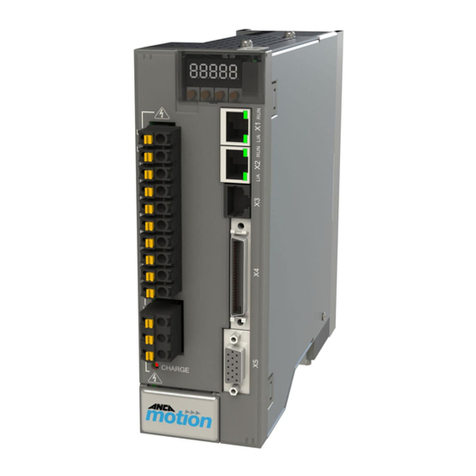
ANCA Motion
ANCA Motion D2 Series user guide
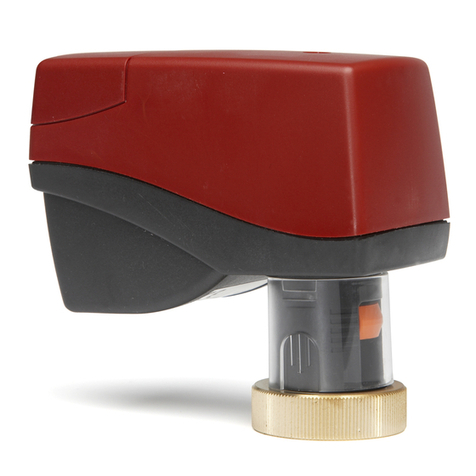
IMI
IMI MC15/24-C Mounting instructions
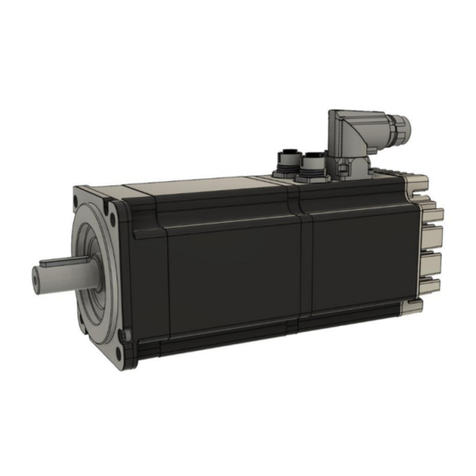
Motor Power Company
Motor Power Company DUET AD Series Reference manual
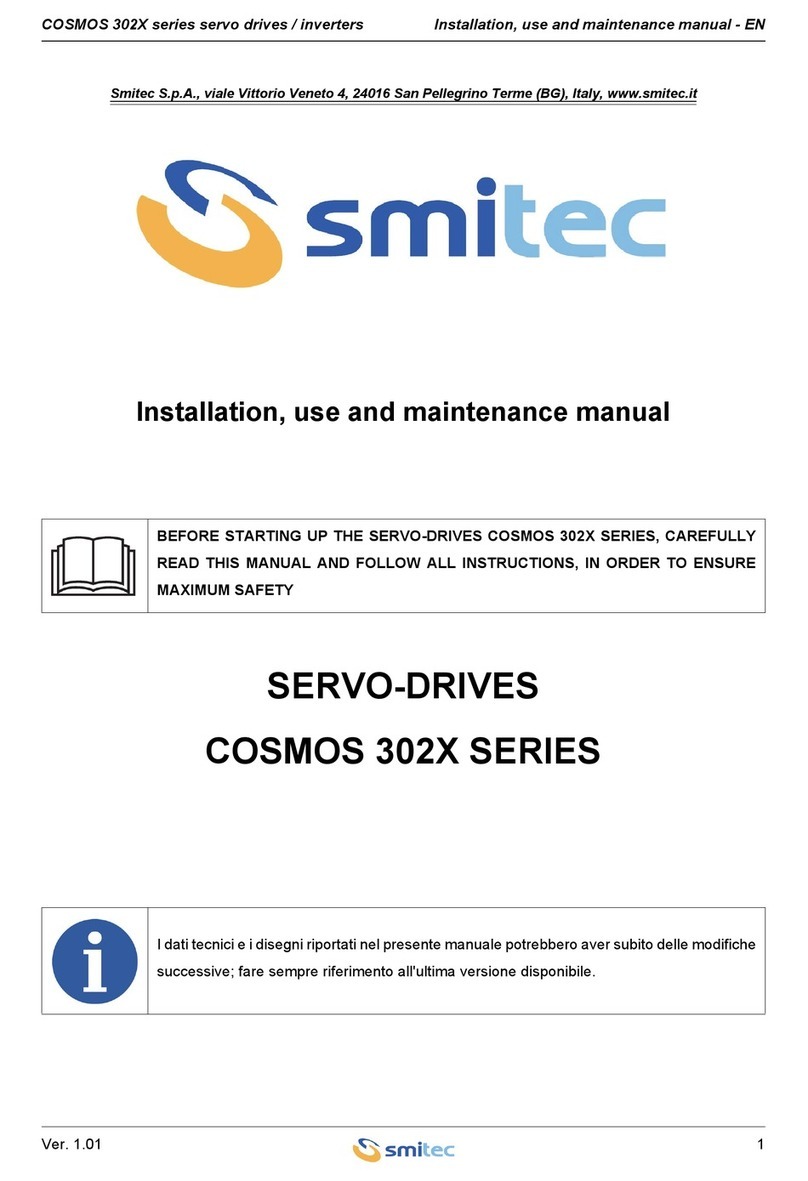
Smitec
Smitec COSMOS 302 Series Installation, use and maintenance manual
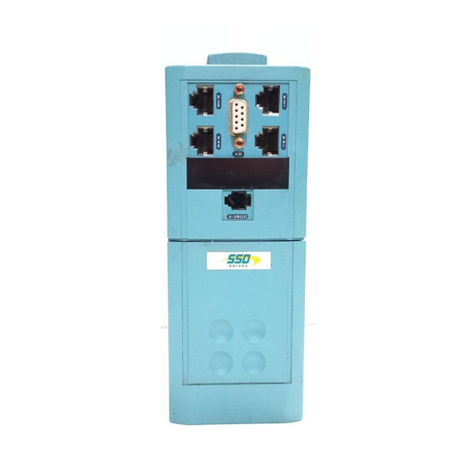
Eurotherm Drives
Eurotherm Drives 631 product manual
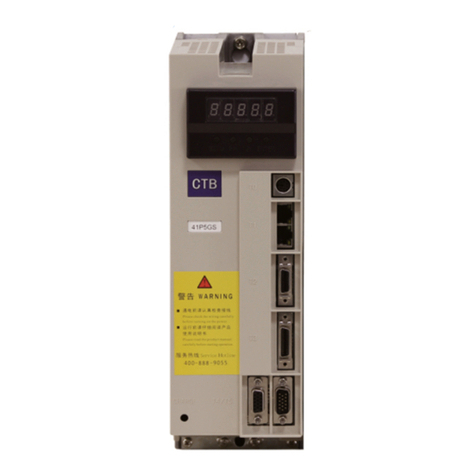
CTB
CTB BKSC GNX Series operating manual
SYNAPTICON
SYNAPTICON SOMANET Circulo Hardware manual
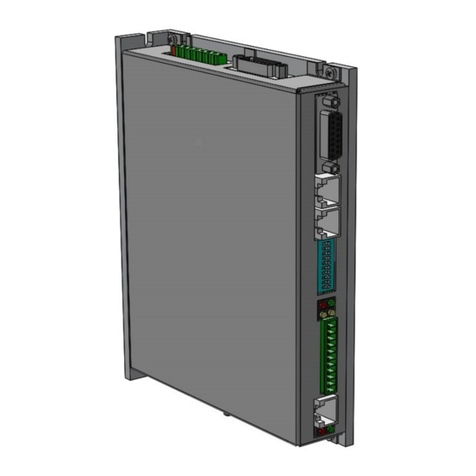
NTI AG
NTI AG LinMot C1400 Series installation guide
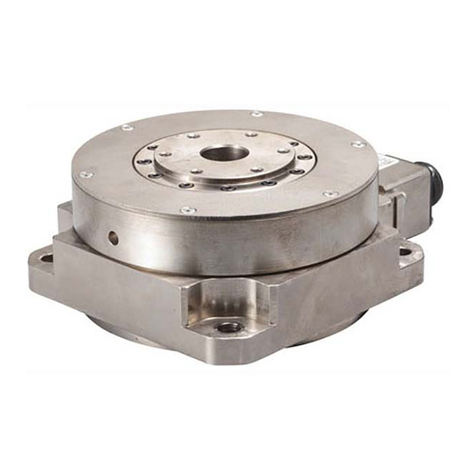
Mitsubishi Electric
Mitsubishi Electric TM-RFM Series user manual
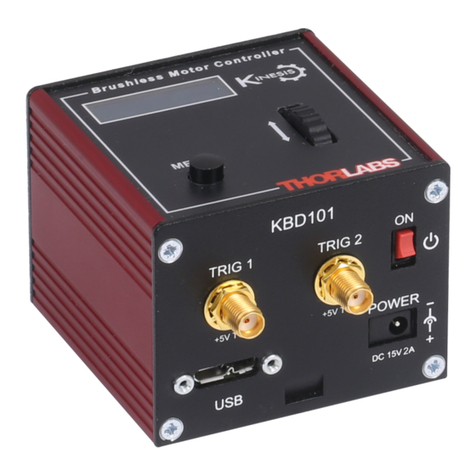
THORLABS
THORLABS KBD101 user guide
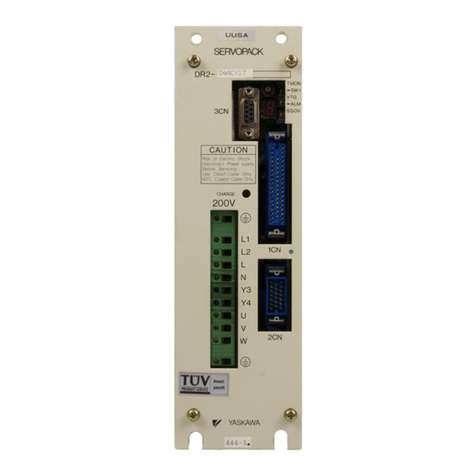
YASKAWA
YASKAWA SGM-A3 user manual
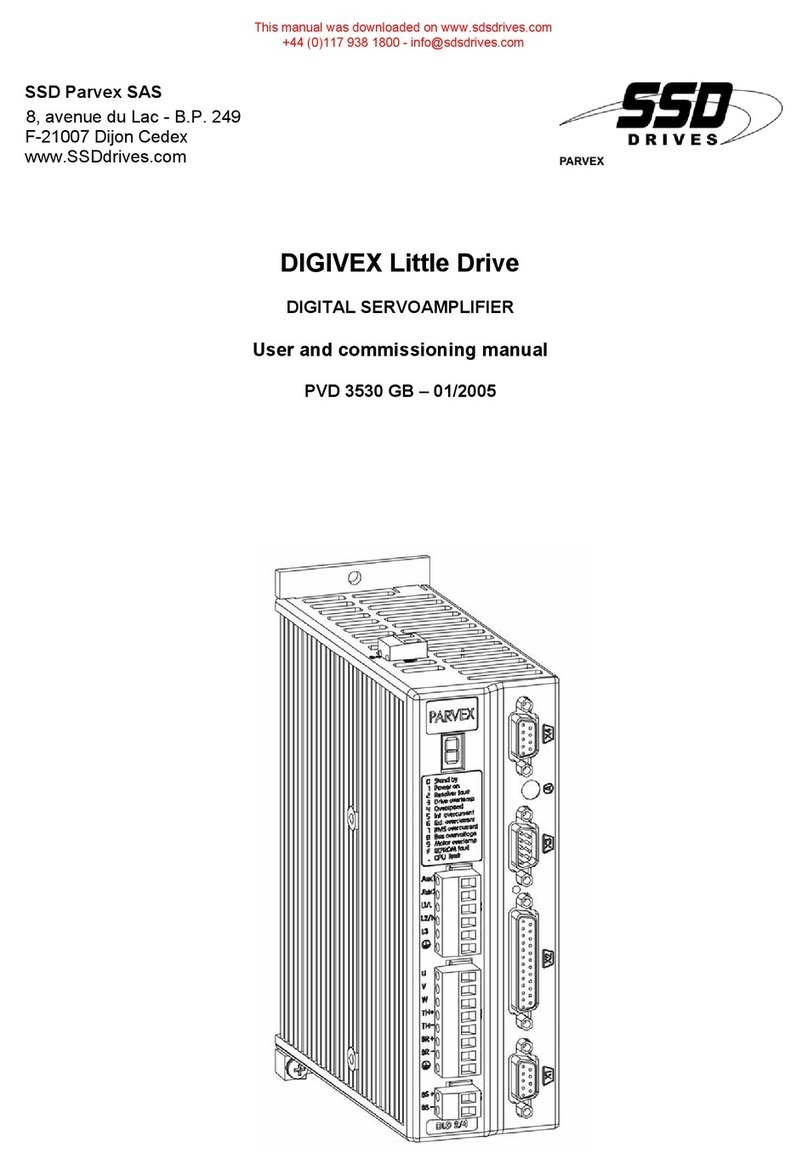
SSD Parvex
SSD Parvex DIGIVEX Little Drive Servoamplifier User and commissioning manual

